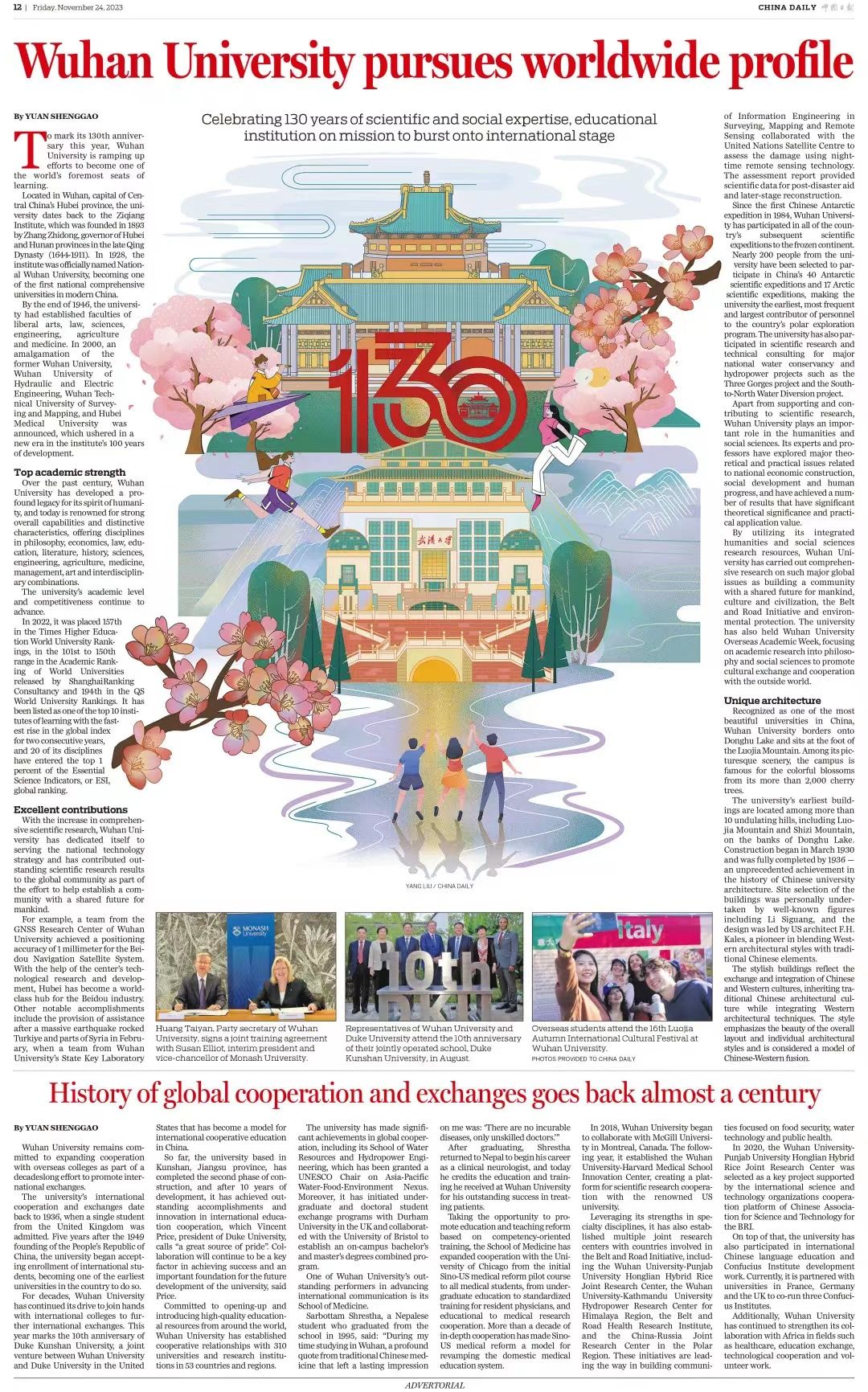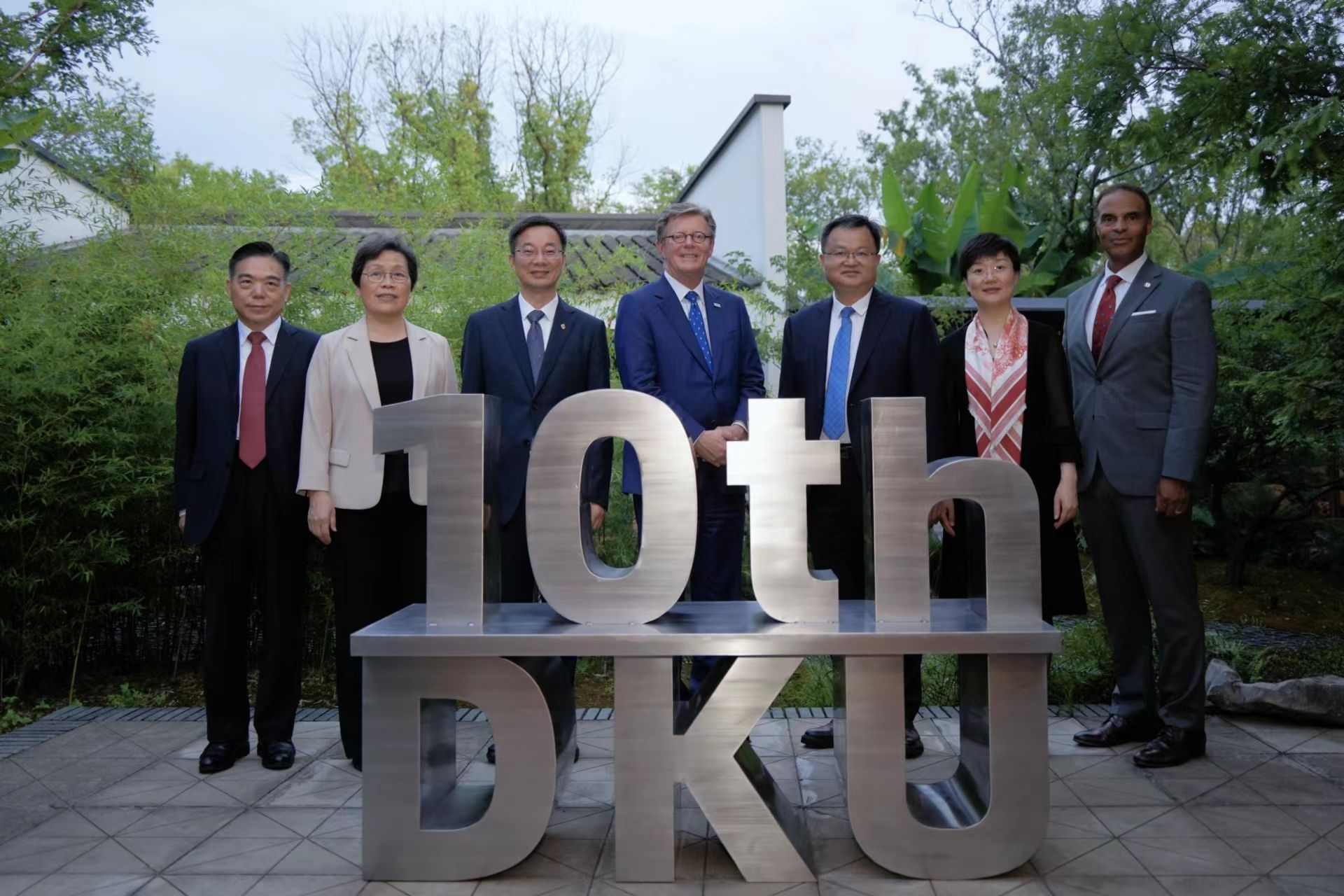Editor's note: Ahead of Wuhan University’s 130th anniversary celebrations, China Daily, one of China’s top national English-language newspapers, has published a series of articles recognizing the university’s growing international profile in its November 24, 2023, edition. In drawing on various highlights across the institution’s 130-year history, the articles offer readers insight into an institution that has grown from strength to strength while further opening its doors to the outside world for the benefit of educational, scientific and social benefits.
【编者按】2023年11月24日于武汉大学130周年庆典前,中国国家英文日报《中国日报》发表了一系列文章,肯定了武汉大学日益增长的国际形象。文章回顾了武汉大学130年历史中的亮点,让读者深入了解到这所不断壮大自己、进一步向外界敞开大门以促进教育、科学和社会效益的高校。文章描绘了武汉大学自1893年成立之初的自强学堂到今天的发展历程;肯定了武汉大学独特的建筑,更深入探讨了其深厚的学术实力和日益增长的国际声誉,而这都体现在全球大学和学科排名中。文章还概述了武汉大学在科学和社会研究方面的杰出贡献及其具有全球意义的实际应用,以及参与国家重要项目的情况。

Wuhan University pursues worldwide profile
Celebrating 130 years of scientific and social expertise, educational institution on mission to burst onto international stage
To mark its 130th anniversary this year, Wuhan University is ramping up efforts to become one of the world's foremost seats of learning.
Located in Wuhan, capital of Central China's Hubei province, the university dates back to the Ziqiang Institute, which was founded in 1893 by Zhang Zhidong, governor of Hubei and Hunan provinces in the late Qing Dynasty (1644-1911). In 1928, the institute was officially named National Wuhan University, becoming one of the first national comprehensive universities in modern China.
By the end of 1946, the university had established faculties of liberal arts, law, sciences, engineering, agriculture and medicine. In 2000, an amalgamation of the former Wuhan University, Wuhan University of Hydraulic and Electric Engineering, Wuhan Technical University of Surveying and Mapping, and Hubei Medical University was announced, which ushered in a new era in the institute's 100 years of development.
Top academic strength
Over the past century, Wuhan University has developed a profound legacy for its spirit of humanity, and today is renowned for strong overall capabilities and distinctive characteristics, offering disciplines in philosophy, economics, law, education, literature, history, sciences, engineering, agriculture, medicine, management, art and interdisciplinary combinations.

YANG LIU/CHINA DAILY
The university's academic level and competitiveness continue to advance.
In 2022, it was placed 157th in the Times Higher Education World University Rankings, in the 101st to 150th range in the Academic Ranking of World Universities released by ShanghaiRanking Consultancy and 194th in the QS World University Rankings. It has been listed as one of the top 10 institutes of learning with the fastest rise in the global index for two consecutive years, and 20 of its disciplines have entered the top 1 percent of the Essential Science Indicators, or ESI, global ranking.
Excellent contributions
With the increase in comprehensive scientific research, Wuhan University has dedicated itself to serving the national technology strategy and has contributed outstanding scientific research results to the global community as part of the effort to help establish a community with a shared future for mankind.
For example, a team from the GNSS Research Center of Wuhan University achieved a positioning accuracy of 1 millimeter for the Beidou Navigation Satellite System. With the help of the center's technological research and development, Hubei has become a world-class hub for the Beidou industry. Other notable accomplishments include the provision of assistance after a massive earthquake rocked Turkiye and parts of Syria in February, when a team from Wuhan University's State Key Laboratory of Information Engineering in Surveying, Mapping and Remote Sensing collaborated with the United Nations Satellite Centre to assess the damage using nighttime remote sensing technology. The assessment report provided scientific data for post-disaster aid and later-stage reconstruction.
Since the first Chinese Antarctic expedition in 1984, Wuhan University has participated in all of the country's subsequent scientific expeditions to the frozen continent. Nearly 200 people from the university have been selected to participate in China's 40 Antarctic scientific expeditions and 17 Arctic scientific expeditions, making the university the earliest, most frequent and largest contributor of personnel to the country's polar exploration program. The university has also participated in scientific research and technical consulting for major national water conservancy and hydropower projects such as the Three Gorges project and the South-to-North Water Diversion project.
Apart from supporting and contributing to scientific research, Wuhan University plays an important role in the humanities and social sciences. Its experts and professors have explored major theoretical and practical issues related to national economic construction, social development and human progress, and have achieved a number of results that have significant theoretical significance and practical application value.
By utilizing its integrated humanities and social sciences research resources, Wuhan University has carried out comprehensive research on such major global issues as building a community with a shared future for mankind, culture and civilization, the Belt and Road Initiative and environmental protection. The university has also held Wuhan University Overseas Academic Week, focusing on academic research into philosophy and social sciences to promote cultural exchange and cooperation with the outside world.
Unique architecture
Recognized as one of the most beautiful universities in China, Wuhan University borders onto Donghu Lake and sits at the foot of the Luojia Mountain. Among its picturesque scenery, the campus is famous for the colorful blossoms from its more than 2,000 cherry trees.
The university's earliest buildings are located among more than 10 undulating hills, including Luojia Mountain and Shizi Mountain, on the banks of Donghu Lake. Construction began in March 1930 and was fully completed by 1936 — an unprecedented achievement in the history of Chinese university architecture. Site selection of the buildings was personally undertaken by well-known figures including Li Siguang, and the design was led by US architect F.H.Kales, a pioneer in blending Western architectural styles with traditional Chinese elements.
The stylish buildings reflect the exchange and integration of Chinese and Western cultures, inheriting traditional Chinese architectural culture while integrating Western architectural techniques. The style emphasizes the beauty of the overall layout and individual architectural styles and is considered a model of Chinese-Western fusion.

Huang Taiyan, Party secretary of Wuhan University, signs a joint training agreement with Susan Elliot, interim president and vice-chancellor of Monash University. CHINA DAILY
Representatives of Wuhan University and Duke University attend the 10th anniversary of their jointly operated school, Duke Kunshan University, in August. CHINA DAILY

Overseas students attend the 16th Luojia Autumn International Cultural Festival at Wuhan University. CHINA DAILY
History of global cooperation and exchanges goes back almost a century
Wuhan University remains committed to expanding cooperation with overseas colleges as part of a decadeslong effort to promote international exchanges.
The university's international cooperation and exchanges date back to 1936, when a single student from the United Kingdom was admitted. Five years after the 1949 founding of the People's Republic of China, the university began accepting enrollment of international students, becoming one of the earliest universities in the country to do so.
For decades, Wuhan University has continued its drive to join hands with international colleges to further international exchanges. This year marks the 10th anniversary of Duke Kunshan University, a joint venture between Wuhan University and Duke University in the United States that has become a model for international cooperative education in China.
So far, the university based in Kunshan, Jiangsu province, has completed the second phase of construction, and after 10 years of development, it has achieved outstanding accomplishments and innovation in international education cooperation, which Vincent Price, president of Duke University, calls "a great source of pride". Collaboration will continue to be a key factor in achieving success and an important foundation for the future development of the university, said Price.
Committed to opening-up and introducing high-quality educational resources from around the world, Wuhan University has established cooperative relationships with 310 universities and research institutions in 53 countries and regions.
The university has made significant achievements in global cooperation, including its School of Water Resources and Hydropower Engineering, which has been granted a UNESCO Chair on Asia-Pacific Water-Food-Environment Nexus. Moreover, it has initiated undergraduate and doctoral student exchange programs with Durham University in the UK and collaborated with the University of Bristol to establish an on-campus bachelor's and master's degrees combined program.
One of Wuhan University's outstanding performers in advancing international communication is its School of Medicine.
Sarbottam Shrestha, a Nepalese student who graduated from the school in 1995, said: "During my time studying in Wuhan, a profound quote from traditional Chinese medicine that left a lasting impression on me was: 'There are no incurable diseases, only unskilled doctors.'"
After graduating, Shrestha returned to Nepal to begin his career as a clinical neurologist, and today he credits the education and training he received at Wuhan University for his outstanding success in treating patients.
Taking the opportunity to promote education and teaching reform based on competency-oriented training, the School of Medicine has expanded cooperation with the University of Chicago from the initial Sino-US medical reform pilot course to all medical students, from undergraduate education to standardized training for resident physicians, and educational to medical research cooperation. More than a decade of in-depth cooperation has made Sino-US medical reform a model for revamping the domestic medical education system.
In 2018, Wuhan University began to collaborate with McGill University in Montreal, Canada. The following year, it established the Wuhan University-Harvard Medical School Innovation Center, creating a platform for scientific research cooperation with the renowned US university.
Leveraging its strengths in specialty disciplines, it has also established multiple joint research centers with countries involved in the Belt and Road Initiative, including the Wuhan University-Punjab University Honglian Hybrid Rice Joint Research Center, the Wuhan University-Kathmandu University Hydropower Research Center for Himalaya Region, the Belt and Road Health Research Institute, and the China-Russia Joint Research Center in the Polar Region. These initiatives are leading the way in building communities focused on food security, water technology and public health.
In 2020, the Wuhan University-Punjab University Honglian Hybrid Rice Joint Research Center was selected as a key project supported by the international science and technology organizations cooperation platform of Chinese Association for Science and Technology for the BRI.
On top of that, the university has also participated in international Chinese language education and Confucius Institute development work. Currently, it is partnered with universities in France, Germany and the UK to co-run three Confucius Institutes.
Additionally, Wuhan University has continued to strengthen its collaboration with Africa in fields such as healthcare, education exchange, technological cooperation and volunteer work.
http://epaper.chinadaily.com.cn/a/202311/24/WS655fef4ca310d4219e3aa485.html
http://epaper.chinadaily.com.cn/a/202311/24/WS655fef4ba310d4219e3aa484.html
(来源:China Daily 2023年11月24日 编辑:赵冀帆)
